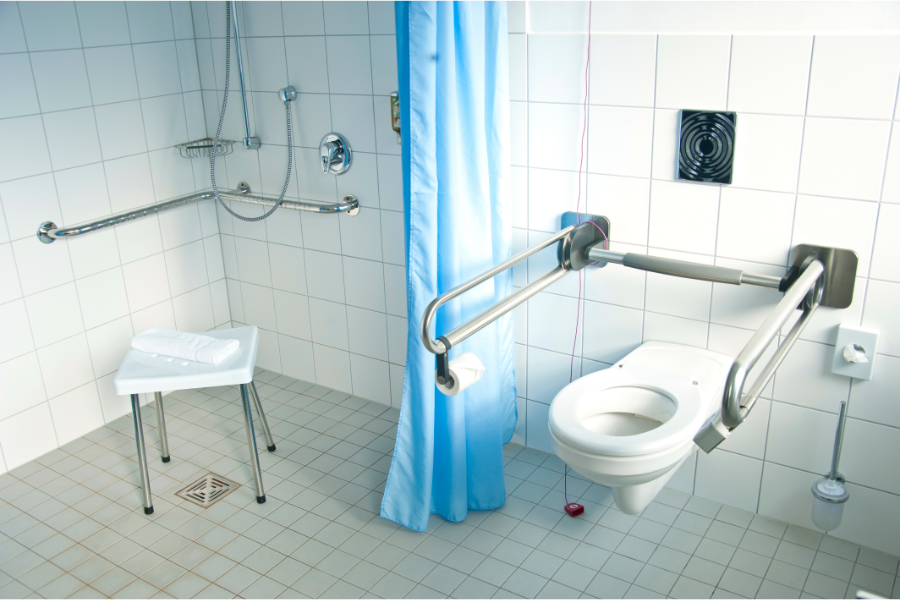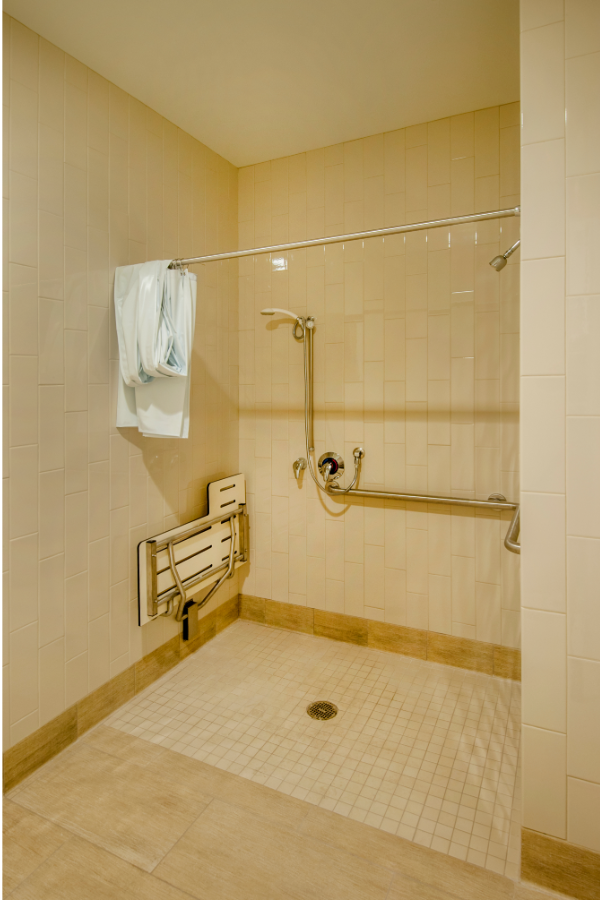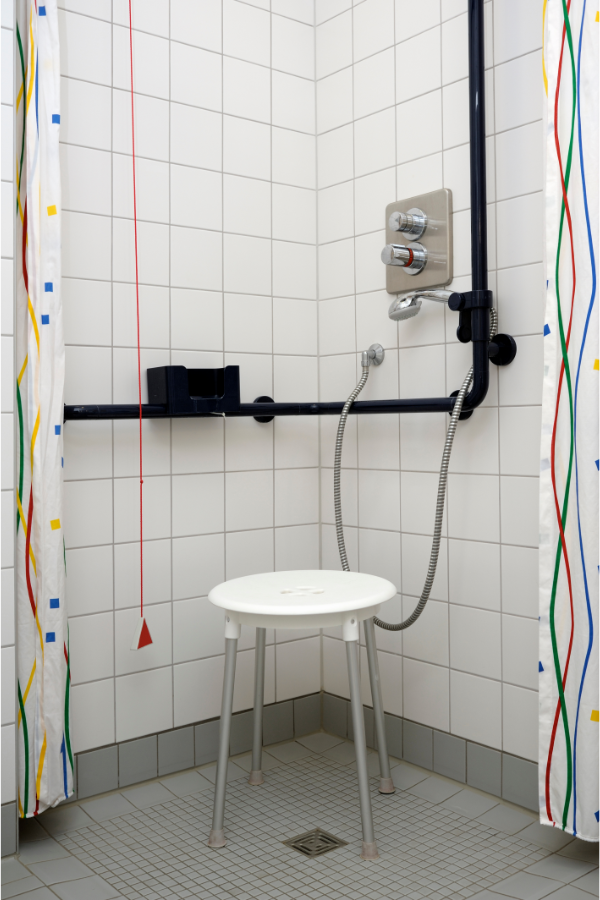When it comes to designing a bathroom that’s accessible for everyone, every detail matters.
One such detail, often overlooked, is the height of the shower valve. This seemingly small aspect can significantly impact the comfort and safety of those with disabilities.

Table of Contents
The Crucial Element: Shower Valve Height
Shower valve height is a key factor in ensuring a safe and comfortable experience, especially for individuals with disabilities. The height determines how easily one can reach and operate the controls. If the valve is too high or too low, it can be difficult to reach, causing discomfort and potentially even safety risks.
The Standard Height: Is It Enough?
The standard height for shower valves, as recommended by most plumbers and builders, is 38 to 48 inches above the floor. This height is based on the average height of adults and is generally considered comfortable for most people. However, when it comes to individuals with disabilities, particularly those who use wheelchairs, this “standard” may not be suitable.
For someone in a wheelchair, it should be positioned at the standard height and should not be too high to reach comfortably. This can make the simple act of taking a shower a challenging and potentially unsafe task. Therefore, it’s crucial to consider individual needs when determining height.
Tailoring The Height for Disabled Individuals
So, what is the ideal shower valve height for individuals with disabilities? The answer isn’t one-size-fits-all. It depends on various factors, including the individual’s height, whether they use a wheelchair and their level of mobility and strength.
As a general guideline, for someone using a wheelchair,it should be installed at a height that’s easy to reach from a seated position. This is typically lower than the standard height, often around 34 to 40 inches from the floor. However, it’s essential to tailor this to the individual’s specific needs for optimal comfort and usability.
The Power of Adjustable Shower Valves
One solution to the challenge of finding the perfect shower valve height is to use an adjustable valve. These valves can be moved up and down along a bar, allowing the height to be adjusted as needed. This flexibility can be particularly beneficial in households where multiple people with different needs are using the same shower.
Adjustable valves offer the advantage of customization. They can be set at a lower height for someone using a wheelchair, then easily raised for a standing user. This adaptability makes them an excellent choice for creating an accessible bathroom that caters to everyone’s needs.
Step-by-Step: Installing a Shower Valve at the Right Height
If you’re renovating a bathroom to improve its accessibility, knowing how to install this at the correct height is crucial. Here’s a step-by-step guide to help you through the process:
- Assess the User’s Needs: Before you begin, consider the needs of the person who will be using the shower. What is their height? Do they use a wheelchair? What is their reach range? These factors will help determine the best height.
- Mark the Height: Once you’ve determined the ideal height, mark it on the wall. This will be where the center of the shower valve will be installed.
- Prepare for Installation: Turn off the water supply. Then, using the manufacturer’s instructions, prepare the shower valve for installation.
- Install the Valve: Attach the shower valve to the plumbing at the marked height. Ensure it’s securely fastened and that all connections are tight.
- Test the Shower: Once the valve is installed, turn the water supply back on and test the shower.
ADA-Compliant Showers: A Step Towards Inclusion
The Americans with Disabilities Act (ADA) is a landmark legislation that has transformed the way we design and build our spaces. It has brought the needs of individuals with disabilities to the forefront, ensuring that public and commercial spaces are accessible to all.
By adhering to the ADA standards for accessible showers, we can create spaces that are safe, comfortable, and accessible to all. These standards are not just about compliance—they are about recognizing the diverse needs of our society and creating spaces that cater to these needs.
Decoding ADA Standards for Accessible Design
The ADA Standards for Accessible Design provide comprehensive guidelines for making various facilities accessible, including bathrooms and showers. These standards are not just legal requirements—they are a blueprint for creating a more inclusive society.
Size and Space: The Cornerstones of Accessibility
Under the ADA standards, an accessible shower must have a specific minimum size. For a roll-in shower, the minimum size is 30 inches by 60 inches. This size ensures that there is enough space for a person using a wheelchair to enter the shower and turn around.
In addition to the size, the shower must also have an accessible route. This means that there should be enough space for a person using a wheelchair to approach, enter, and exit the shower.

Controls and Equipment: Ensuring Ease of Use
The ADA standards also specify requirements for shower controls and equipment. All controls, including faucets and shower sprays, should be operable with one hand and should not require tight grasping, pinching, or twisting of the wrist. The controls should be located on an accessible wall, and the highest operable part should be within 48 inches of the shower floor.
In addition to the controls, the shower should also be equipped with a folding seat and grab bars. The seat should be located on the wall adjacent to the controls and should be 17 to 19 inches above the shower floor. The grab bars should be installed on the walls adjacent to and opposite the seat.
Shower Enclosures and Doors: Prioritizing Accessibility
The ADA standards also provide guidelines for shower enclosures and doors. If a shower has a door, it should be outward swinging and should have a clear opening width of at least 32 inches when open 90 degrees. The door should also have a clear floor space on both sides.
Non-Slip Surfaces and Drainage: Safety First
To prevent slips and falls, the shower floor should have a non-slip surface. The shower should also have a self-draining shower pan to prevent water from pooling on the floor.
Beyond the Valve: Other Accessibility Considerations
While shower valve height is a critical aspect of bathroom accessibility, it’s not the only factor to consider. Other modifications can further enhance the safety and usability of the bathroom for individuals with disabilities.
Grab Bars: A Helping Hand
Installing grab bars in the bathroom can provide additional support and stability. These bars can be placed at various heights to accommodate different needs and can be particularly helpful for individuals with balance or mobility issues.
Non-Slip Mats: Safety First
A non-slip mat can help prevent falls, a common hazard in bathrooms. These mats provide extra grip, making it safer for everyone, especially those with mobility issues.
Handheld Shower Heads: Flexibility at Its Best
A handheld shower head can be a game-changer for individuals with disabilities. It allows the user to direct the water where they need it, offering more control and flexibility than a fixed shower head.
Shower Seats: Comfort and Ease
For individuals who have difficulty standing for extended periods, a shower seat can be a great addition. Combined with a handheld shower head and an accessible shower valve, a seat can make taking a bath a much more comfortable experience.

The Right Faucet Makes a Difference
While shower valve height plays a crucial role in bathroom accessibility, faucets too deserve their share of attention. Just like shower valves, the design and placement of faucets can significantly impact the comfort and independence of individuals with disabilities. From the height and reach of the faucet to the ease of operation, every detail matters.
Choosing the right faucet is about more than just aesthetics. For individuals with limited mobility or strength, lever-operated or touchless faucets can be much easier to use than traditional knob-style faucets. Similarly, a faucet that’s installed at a height and location that’s easy to reach can make a world of difference for wheelchair users.
Faucets and Universal Design
Incorporating accessible faucets is a key aspect of universal design – a design approach that aims to make spaces usable by as many people as possible, regardless of age, ability, or status in life. By choosing accessible faucets and installing them at the right height, we can create bathrooms that are not only more inclusive but also more user-friendly for everyone.
How Good Lighting Helps
Good lighting is essential in a bathroom, especially for individuals with visual impairments. Ensure the area is well-lit to prevent accidents and make it easier to use the shower controls.
Making the Right Choices: Consult a Professional
When it comes to creating an accessible bathroom, it’s always a good idea to consult with a professional. They can provide valuable advice and ensure that all modifications meet the necessary safety standards and regulations.
Every Detail Matters: Creating an Accessible Bathroom
Creating an accessible bathroom involves careful consideration of every detail, from the shower valve height to the type of shower head used. By making these thoughtful modifications, you can create a space that’s not only functional but also comfortable and safe for individuals with disabilities.
FAQ
- What is the standard height for shower valves? The standard height as recommended by most plumbers and builders, is 38 to 48 inches above the floor. However, this may not be suitable for everyone, especially individuals with disabilities.
- What is the ideal valve height for individuals with disabilities? The ideal shower valve height for individuals with disabilities depends on various factors, including the individual’s height, whether they use a wheelchair and their level of mobility and strength. For someone using a wheelchair, the valve should be installed at a height that’s easy to reach, often around 34 to 40 inches from the shower floor.
- What are adjustable shower valves? Adjustable shower valves can be moved up and down along a bar, allowing the height to be adjusted as needed. This flexibility can be particularly beneficial in households where multiple people with different needs are using the same shower.
- How do I install a shower valve at the correct height? Installing a shower valve at the correct height involves assessing the user’s needs, marking the ideal height on the wall, preparing for installation, attaching the shower valve to the plumbing at the marked height, and testing it.
- What other modifications can improve bathroom accessibility? Other modifications that can improve bathroom accessibility include installing grab bars, using non-slip mats, using a handheld shower head, and adding a seat. Good lighting is also essential, especially for individuals with visual impairments.
More Reading:
